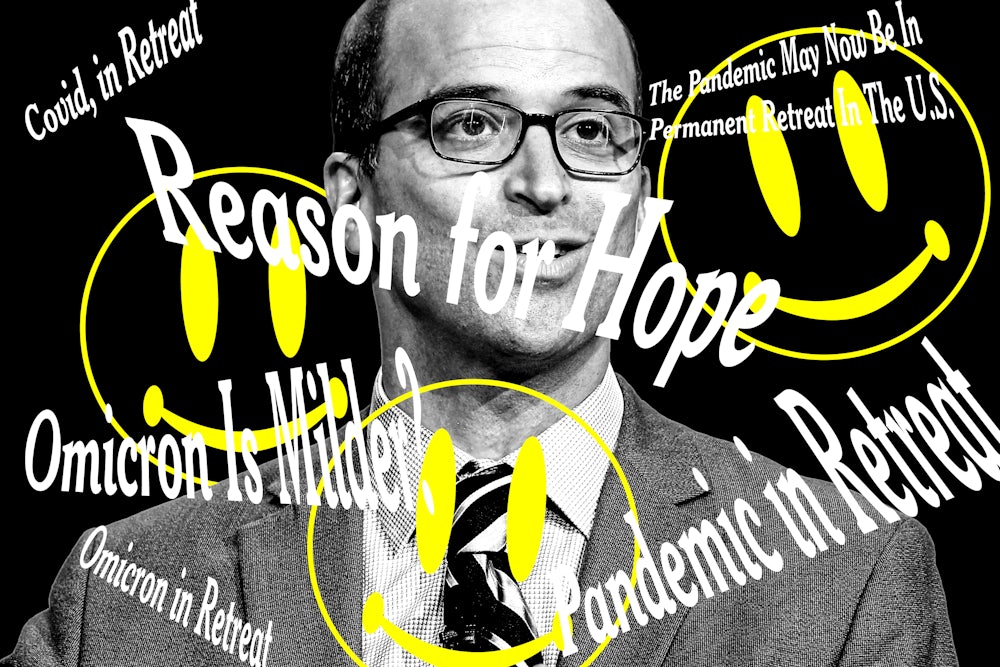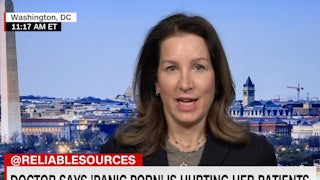I have been reading David Leonhardt’s New York Times newsletter, The Morning, for the better part of the last year, and I cannot for the life of me decide if he is Dr. Pangloss or if he is Candide—the relentless crackpot optimist or the disappointed student who finally throws up his hands and concludes that we must, each of us, tend our gardens alone.
Perhaps he’s both. He memorably complained about the news media’s “bad news bias” in March 2021, arguing that journalists were paying too much attention to places where cases of Covid-19 were rising and were not paying enough attention to promising developments. He devoted several installments of his own newsletter to heralding the good news. On February 11, 2021, The Morning carried the headline, “Pandemic in Retreat.” By April of the same year, Leonhardt was castigating the “many vaccinated people [who] continue to obsess over the risks from Covid,” offering what we now know to be a highly inaccurate picture of the vaccines’ effectiveness at reducing transmission of the SARS-CoV-2 virus, and experimenting with an argument that would become a recurring favorite: that we easily accept tens of thousands of road deaths every year, so why should Covid be any different? He soon announced that “the pandemic may now be in permanent retreat in the U.S.” He acknowledged that “globally, the situation is not as encouraging,” but he could not imagine this as anything but a problem for poor countries with “lower vaccination rates.” Ten days after that column, the World Health Organization named B.1.617.2 the delta variant, and just a few weeks after that, the Centers for Disease Control and Prevention designated it a “variant of concern.” In June, the WHO announced that it was becoming the dominant global strain.
The spectacular explosions of the delta and then the omicron variant that fall and winter proved the optimistic prognosticators wrong. In the year that followed Leonhardt’s February 2021 “Pandemic in Retreat” article, more than 400,000 people died of Covid-19 in the United States. But numbers did little to dampen his optimism. In October 2021, he was once again pronouncing “Covid, in Retreat.” Amid the deadly omicron surge in January, he broadcast “Reason for Hope” (January 3) and declared “Omicron in Retreat” (January 19, a day with a reported 3,376 Covid deaths in the U.S). Leonhardt’s newsletter post on January 5 melded confident optimism in its headline, “Omicron Is Milder,” with his taste for individualistic thinking in the subhead: “How should that affect your behavior?”
Calculations of trade-offs and individual risk tolerance have become The Morning’s stock-in-trade. “My best attempt is to say that the Covid risks for most vaccinated people are of the same order of magnitude as risks that people unthinkingly accept every day, like riding in a vehicle,” Leonhardt wrote in September. He chuckled at CDC guidelines that refer to “medium-rare hamburgers as ‘undercooked’ and dangerous” or tell “sexually active women of childbearing age not to drink alcohol unless they are on birth control,” and used them to mock those who are “following the science” on the pandemic as needless worriers. The effect is to treat the pandemic’s still-growing toll of death and debilitation as just one more buzz in the background noise of violent death and destruction that we have come to accept as the American norm. The “only plausible long-term future for Covid,” as he sees it, is one in which the illness and death it causes becomes “a more normal part of daily life.”
The Morning reputedly has more than five million readers. We should be skeptical of any self-reported audience metrics in online media, but there’s no question that Leonhardt is “arguably the most influential of the Covid influencers,” as Politico recently put it, with a readership that includes leaders in business, academia, and politics, up to and including the president himself. It’s easy to see why. Leonhardt has cultivated the confident, chatty, and self-assured tone of much of America’s professional classes—the sort of people who make dinner-party conversation about “an article I just read” or “a story I heard on NPR.” The text of the newsletter is usually short—a thousand words or so, just a bit longer than the typical opinion column; generally treats one or two current topics in the news; and typically offers up what the Times labels “news analysis,” which is supposed to be distinct from “opinion,” although how the distinction is drawn is not very clear. These columns are then followed by a curated roundup of news links and brief synopses. The newsletter specializes in giving the reader a “way to think” about the latest news, and it ranges across a panoply of subjects. Covid. The labor market. Ukraine. The evaluative question is therefore a simple one. Does this guy actually know what he’s talking about? The answer is: not exactly.
Leonhardt cut his teeth as a business and economics writer (for which he ultimately won a Pulitzer) and later worked on the Times’ efforts to integrate data analysis and visualization with reporting at The Upshot, which was widely perceived to be a replacement for the work of Nate Silver, who’d left the company to found his website, FiveThirtyEight, although Leonhardt denied that this was the case. Regardless, this kind of explanatory journalism, which combines statistics and economics to flatter readers’ sense of themselves as savvy consumers of data-driven news, even as it relies upon their inability actually to parse the underlying data, was and remains a popular and growing niche.
The Covid pandemic has amplified the popularity and the centrality of such reporting. While many Americans—the people who have what we stopped calling “essential” jobs the moment they started making demands—have encountered the pandemic as a terrifying and discombobulating personal and social catastrophe, it has been easier for those with a certain level of educational attainment, a home office, and a white-collar job to perceive it very much as an abstract explosion of statistics, creating a built-in audience for economists, statisticians, and others in the “explainer” industry to transform case and hospitalization numbers, epidemiological models, vaccine efficacy rates, aggregate job losses and job gains, and individual probabilities of contracting the disease into arguments that we should be doing less, not more, to control the spread of the disease.
Reporters have worked to present and parse this dizzying explosion of data, scientific and otherwise, but writers of news analysis have often been glibly, insouciantly, and bafflingly wrong, even as they adopt a voice of benign self-assurance. The Morning, for instance, has an awkward record of making claims that prompt actual experts, usually beleaguered epidemiologists, to rush in with corrections. (Take Leonhardt’s infamous claim that a vaccinated person had a 1 in 5,000 chance of contracting Covid-19—to which the epidemiologist Justin Feldman responded with a long Slate article, titled, “All the Ways That “1 in 5,000 Per Day” Breakthrough Infection Stat Is Nonsense.”) Arguments to abandon public health measures on the grounds that only a few people remain vulnerable are also frequently morally callous. “Population sample sizes can vary by billions, but a single life remains a static sum,” wrote the Catholic critic, David Bentley Hart, reviewing notorious optimist Steven Pinker’s proposition that the world is now far less violent than it once was.
Leonhardt is not immune to criticism, and he is somewhat responsive to critics, but the responses often point to a frustrating inability to engage with the substance of the critiques. When he appeared on the Times podcast The Daily in late January to talk about his article, “Two Covid Americas,” a barrage of complaints followed. His laser focus on individual risk and behavior, public health experts and academics pointed out, did a huge disservice to immunocompromised, chronically ill, unvaccinated (including those too young to be vaccinated), and other vulnerable populations. In his February 14 edition of The Morning, he appeared to backtrack slightly with a piece called “Protecting the Vulnerable,” which outlines “five steps that can help protect the vulnerable as society moves back toward normal.” These steps consist of getting vaccinated, continuing to mask while the rest of society moves on, rapid testing, and getting hold of “difficult to locate” pharmaceuticals. He gestures vaguely in the direction of some kind of actual policy—“government agencies, hospitals and doctor’s offices can also play a crucial role, helping people locate potentially lifesaving treatments,” he writes—but shows little interest in how and whether these things will actually appear out of nowhere. Meanwhile, we are learning more every day about the ineptitude of the Biden administration in this arena, including a failure to properly earmark funds for the purchase of millions of doses of Paxlovid, Pfizer’s Covid-fighting drug. Point five of Leonhardt’s five-point plan, for those keeping score.
Newsletters and podcasts are increasingly displacing editorial boards as outlets for the newspaper’s economic and political ideologies. Agree or disagree with their viewpoints, a Bret Stephens or Maureen Dowd or Ross Douthat column is branded as a set of their distinct, personal opinions and can plausibly be framed as part of the paper’s larger commitment to publishing a diverse range of voices and views in a space that is plainly labeled as the Opinion section. Leonhardt, in contrast, has been assigned to write the Times’ flagship newsletter—a basic point of entry for subscribers who want to “make sense of the day’s news and ideas”—and his words carry the institutional authority of the paper of record.
And they follow a strong ideological line. Leonhardt’s writing for The Morning represents the dominant elite consensus that Covid will soon be endemic and that the supposed social costs of collective mitigation are too high—read: too annoying and inconvenient—to bear any longer. In this account, it is inevitable that everyone will get infected sooner or later but emphatically not because all of our wrong decisions and terrible failures of public policy made it so; masking had a time, but it is over for most of us because of its nebulous psychological and emotional effects on children; vulnerable people and populations, like people with disabilities, should be accommodated where possible, if it is not too expensive and unwieldy, but their individual needs should not compel changes or alterations to “normal” life—never mind that more than a quarter of U.S. adults are disabled. In Morning-land, the far right is a problem, but it is the left that risks going too far, alienating Democratic constituencies by causing the party to “lurch” to the left, even though the most powerful and influential people in the party—Joe Biden, Nancy Pelosi, Joe Manchin, Chuck Schumer—are profoundly centrist, even conservative, in their views. Social interventions at scale, whether to address health crises, economic inequality, racial injustice, or climate, are impractical and impossible in a divided polity, and smart or “targeted” solutions and interventions represent the best—the only—public policy.
That Leonhardt consistently pushes this line is not some matter of deliberate subterfuge; no one believes (well, no one should believe, anyway) that anyone at the New York Times is telling him what position to take. There is, however, little question that the Times management has made a choice to put him in the position he is in, opining to the audience to which he opines, because of what he believes. As Noam Chomsky memorably told the BBC’s Andrew Marr in an interview in the 1990s: “I’m sure you believe everything you say. But what I’m saying is if you believed something different, you wouldn’t be sitting where you’re sitting.”
What is interesting about newsletter format in promulgating these views is the way that it has serialized them, replacing the stentorian, big-screen voice of the unsigned editorial with the episodic drip-drip of favorite characters, conflicts, and themes. For many readers, I suspect, Leonhardt—along with a handful of similar personalities at other publications and in forums like Substack—occupies a not dissimilar role to that of any beloved TV character, a parasocial almost-friend whose periodized adventures succeed not in spite of their repetitive familiarity, but because of it. The fact that Leonhardt is himself something of a cipher as a personality, largely immune even from relatively friendly attempts to profile him, ironically makes it easier to imagine him as an acquaintance. In this regard Leonhardt is a genius of the form, and I must admit that I have a grudging admiration for his perverse accomplishment. For his devoted audience, he has turned himself into a classic point-of-view character, a stand-in through which spectators can imagine themselves taking part of the story they are being told. That they are part of that story, however protected they may be by education, employment, and class, is ironic as well.
In recent weeks, Leonhardt and The Morning have turned their attention to the set of international crises caused by Russia’s invasion of Ukraine. Here too Leonhardt seemed initially inclined to a kind of optimism. “Is Ukraine Cooling?” he asked on February 16, and, like many American interlocutors, he expressed hope that stiffer-than-expected Ukrainian resistance, at least in the north around Kyiv, might augur a less terrible outcome than an entrenched full-scale war and occupation, although he was careful to cite “military experts” cautioning “against confusing a war’s initial days with its likely result,” and he is now coming around to the more brutal reality. I won’t fault him too much for this trajectory; I, too, doubted that Vladimir Putin would risk a conflict of this scale until the moment when he proved me and many others quite thoroughly and appallingly incorrect.
Even still, Leonhardt allows himself to wonder hopefully if “the war, which already seems to be somewhat unpopular within Russia, will become even more so.” Here, I think, we are back to projecting certain American policy preferences onto what is supposed to be an analytical reading of events. It is certainly true that Russian cities have seen some very brave protests by anti-war Russians, at great personal risk to themselves and their families, and it is very pleasing to think that Western sanctions will strengthen their hand. Yet if there is one thing we have learned in the U.S. and “the West,” it is that popular protest cannot stop a war that political leadership is intent on waging. This seems to be an important point and caveat, but Leonhardt—and the American media broadly—does not like to see parallels between the U.S. and its adversaries, even when (especially when?) our adversaries are in the wrong. And Leonhardt’s own good news bias is terrifyingly poorly calibrated for the reality of a possible conflict between nuclear superpowers, a catastrophic eventuality that he dismisses with blithe and triumphalist appeals to America’s actions against Iraq in the First Gulf War.
“Those who argue that all is well have spoken foolishly,” Dr. Pangloss tells Candide in Voltaire’s opening chapter. “They should have said it is for the best.” The world is not necessarily good or benevolent, but it is, rather, as it must be. If there is a criticism of The Morning, and of the political tendency that I think it represents, it is that it uses an attitude of measurement and calm analysis to convince its audience that quietism is a political virtue and that politics and policy simply happen because the world is as it is and it cannot be otherwise. Public sentiment emerges from the ether; it can sour on policies, but it cannot be turned toward them; popular feelings exist, but risk is individual. Persuasion is the best tool that public officials have, but persuasion only works on the persuadable. For those who are sick or vulnerable, unhoused or unsupported, or simply for those who haven’t acceded to our wise counsel about how—within reason—to stay safe: We wish them well, but we can feel comfortable knowing that, good or ill, whatever happens probably had to, and is for the best.






